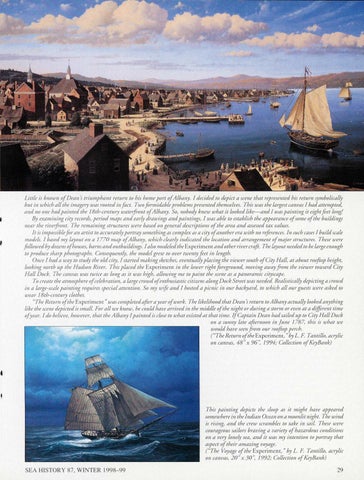Little is known ofDeans triumphant return to his home port ofAlbany. I decided to depict a scene that represented his return symbolically but in which all the imagery was rooted in fact. Two formidable problems presented themselves. This was the largest canvas I had attempted, and no one had painted the 18th-century waterfront ofAlbany. So, nobody knew what it looked like-and I was painting it eight feet long! By examining city records, period maps and early drawings and paintings, I was able to establish the appearance ofsome ofthe buildings near the riverfront. The remaining structures were based on general descriptions of the area and assessed tax values. It is impossible for an artist to accurately portray something as complex as a city ofanother era with no references. In such cases I build scale models. I based my layout on a 1770 map ofAlbany, which clearly indicated the location and arrangement ofmajor structures. These were followed by dozens ofhouses, barns and outbuildings. I also modeled the Experiment and other river craft. The layout needed to be large enough to produce sharp photographs. Consequently, the model grew to over twenty feet in length. Once I had a way to study the old city, I started making sketches, eventually placing the viewer south ofCity Hall, at about rooftop height, looking north up the Hudson River. This placed the Experim ent in the lower right foreground, moving away from the viewer toward City Hall Dock. The canvas was twice as long as it was high, allowing me to paint the scene as a panoramic cityscape. To create the atmosphere ofcelebration, a large crowd ofenthusiastic citizens along Dock Street was needed. Realistically depicting a crowd in a large-scale painting requires special attention. So my wife and I hosted a picnic in our backyard, to which all our guests were asked to wear 18th-century clothes. "The Return ofthe Experiment " was completed after a year ofwork. The likelihood that Deans return to Albany actually looked anything like the scene depicted is small. For all we know, he could have arrived in the middle ofthe night or during a storm or even at a different time ofyear. I do believe, however, that the Albany I painted is close to what existed at that time. If Captain Dean had sailed up to City Hall Dock on a sunny late afternoon in June 1787, this is what we would have seen from our rooftop perch. (''The Return ofthe Experiment," by L. F Tantillo, acrylic on canvas, 48 "x 96''. 1994; Collection ofKeyBank)
• This painting depicts the sloop as it might have appeared somewhere in the I ndian Ocean on a moonlit night. The wind is rising, and the crew scrambles to take in sail. These were courageous sailors braving a variety of hazardous conditions on a very lonely sea, and it was my intention to portray that aspect oftheir amazing voyage. ("The Voyage ofthe Experiment," by L. F. Tantillo, acrylic on canvas, 20" x 30 ''. 1992; Collection ofKey Bank)
SEA HISTORY 87, WINTER 1998-99
29
